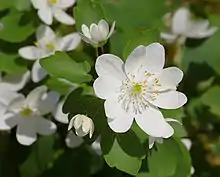| Thalictrum thalictroides | |
|---|---|
 | |
| Scientific classification | |
| Kingdom: | Plantae |
| Clade: | Tracheophytes |
| Clade: | Angiosperms |
| Clade: | Eudicots |
| Order: | Ranunculales |
| Family: | Ranunculaceae |
| Genus: | Thalictrum |
| Species: | T. thalictroides |
| Binomial name | |
| Thalictrum thalictroides | |
| Synonyms | |
| |
Thalictrum thalictroides (syn. Anemonella thalictroides), the rue-anemone[2] or windflower,[1] is a herbaceous perennial plant native to woodland in eastern North America. It has white or pink flowers surrounded by a whorl of leaflets, and it blooms in spring.
Description
_(7361638674).jpg.webp)
Thalictrum thalictroides is a hairless plant growing from a cluster of tuberous roots, with upright stems 10 to 30 cm (4 to 12 in) tall that end with flowers. The basal leaves have petioles (leaf stalks) 10–30 cm (4–12 in) long and leaf blades that are two times ternately compound. The leaflets are widely rounded in shape and the ends are three lobed.[3]
It flowers in spring, with flowers are borne singly or in umbel-like inflorescences with 3 to 6 flowers.[3] The flowers have short stems that hold the fully opened flowers above the foliage. The involucral bracts have three leaflets like the leaves. The showy rounded flowers have 4-15 carpels surrounded by many yellow stamens in the middle, and a cup of 5 to 10 white to pinkish-lilac petal-like sepals.[4][5] The sepals are about 5 to 18 mm (3⁄16 to 11⁄16 in) long and the filaments 3–4 mm (1⁄8–3⁄16 in) long.[3]
In late spring, 3 to 4.5 mm (1⁄8 to 3⁄16 in) long, ovoid to fusiform shaped fruits called achenes are released. The green achenes have 8 to 10 prominent veins and become dark brown when ripe.[3]
Taxonomy
_Eames_%2526_B._Boivin_Rue_anemone.tiff.jpg.webp)
Originally described as Anemone thalictroides by Linnaeus in 1753, it was transferred to a new, monospecific genus, Anemonella, by Édouard Spach in 1839.[6] Although similar to plants in the genus Thalictrum, Sprach considered the diminutive size, umbelliform inflorescence, and tuberous roots of this species to be distinctive enough to designate a new genus. Bernard Boivin considered this distinction suspect, and transferred the species to the genus Thalictrum in 1957.[7] Molecular evidence supports the placement of the species within Thalictrum,[8] and this placement is accepted by several modern treatments,[3] although The Plant List retains it in Anemonella.[9]
Habitat
It typically inhabits banks and thickets in low-lying deciduous woodland, at 0–300 m (0–984 ft).[10] Distribution is mainly in the north eastern United States, and Ontario in Canada.
Similar species
The rue-anemone is often confused with the similar species, the false rue-anemone (Enemion biternatum). Both plants have white flowers that appear in early spring and grow in wooded areas. However, the false rue-anemone is more likely to be found in moist bottomlands and can form large colonies, while the rue-anemone grows singly on wooded slopes. Sometimes rue-anemone sepals are pale to dark pink, whereas false rue-anemone sepals are always white. The false rue-anemone holds its flowers in leaf axils, most often singly. In contrast, the flowers of a rue-anemone appear in a cluster above a whorl of leaf-like bracts, most often in groups of three to six. While false rue-anemones always have five sepals, rue-anemones can have five to ten sepals.[11] False rue-anemones have a small cluster of no more than six green carpels in the center of the flower, while rue-anemones sometimes have as many as fifteen. False rue-anemones usually have deep clefts in their leaves, while rue-anemones do not.[12]
References
- 1 2 NatureServe (5 January 2024). "Thalictrum thalictroides". NatureServe Network Biodiversity Location Data accessed through NatureServe Explorer. Arlington, Virginia: NatureServe. Retrieved 14 January 2024.
- ↑ "Thalictrum thalictroides". Germplasm Resources Information Network. Agricultural Research Service, United States Department of Agriculture.
- 1 2 3 4 5 Park, Marilyn M.; Festerling Jr., Dennis (1997). "Thalictrum thalictroides". In Flora of North America Editorial Committee (ed.). Flora of North America North of Mexico (FNA). Vol. 3. New York and Oxford: Oxford University Press – via eFloras.org, Missouri Botanical Garden, St. Louis, MO & Harvard University Herbaria, Cambridge, MA.
- ↑ Hilty, John (2020). "Rue Anemone (Thalictrum thalictroides)". Illinois Wildflowers.
- ↑ Tenaglia, Dan. "Anemonella thalictroides page". Missouri Plants. Missouri Botanical Garden.
- ↑ Spach, Édouard (1839). Histoire naturelle des vegetaux Phanerogames. Vol. 7. pp. 186–409.
- ↑ Boivin, Bernard (1957). "Études Thalictrologiques III: Réduction du genre Anemonella Spach". Bulletin de la Société Royale de Botanique de Belgique. 89: 319–321. JSTOR 20792255.
- ↑ Ro, K.; McPhearson, B. A. (July 1997). "Molecular phylogeny of the Aquilegia group (Ranunculaceae) based on internal transcribed spacers and 5.8S nuclear ribosomal DNA". Biochemical Systematics and Ecology. 25 (5): 445. doi:10.1016/s0305-1978(97)00029-x.
- ↑ "Anemonella thalictroides". World Checklist of Selected Plant Families. Royal Botanic Gardens, Kew. Retrieved 2015-04-26 – via The Plant List. Note that this website has been superseded by World Flora Online
- ↑ Flora of North America Editorial Committee (ed.). "Thalictrum thalictroides". Flora of North America North of Mexico (FNA). New York and Oxford: Oxford University Press – via eFloras.org, Missouri Botanical Garden, St. Louis, MO & Harvard University Herbaria, Cambridge, MA.
- ↑ Dennison, Edgar (2017). Missouri Wildflowers (Sixth ed.). Conservation Commission of the State of Missouri. pp. 8–9. ISBN 978-1-887247-59-7.
- ↑ "Confusing rues: identifying false rue anemone and rue anemone". Illinois Native Plant Society. 9 May 2021.
External links
- Thalictrum thalictroides in the CalPhotos photo database, University of California, Berkeley
- Thalictrum thalictroides on the Native Plant Identification Network (NPIN)
- Thalictrum thalictroides (Rue Anemone) page on Minnesota Wildflowers
- Thalictrum thalictroides page on Ontario Wildflowers
- Thalictrum thalictroides page in Michigan Flora
- Thalictrum thalictroides in Wildflowers of the United States
